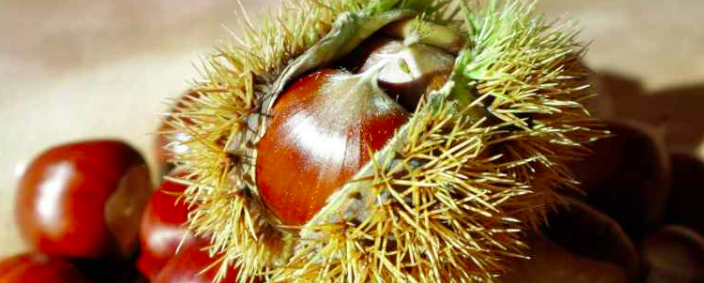
Chestnut is the fruit of certain varieties of chestnut, native to the Balkans. Chestnuts are eaten roasted or boiled or used to make purees, desserts and, in confectionery, glazed chestnuts. It is found on our stalls between the end of September and mid-November and it is often present on our festive holiday tables.
Characteristics of brown:
- Source of fiber;
- Low in fat;
- Provides energy to athletes;
- Source of vitamin B9;
- Suitable for gluten intolerant.
What is brown?
Brown identity card
- Family: Fagaceae;
- Origin: Balkan;
- Season: Late September to mid-November;
- Color: Dark brown;
- Flavor: Sweet and fine.
Characteristics of brown
When harvested, the chestnut is an oval fruit of about four centimeters, surrounded by a thick prickly skin called “bug”.
Differences with nearby foods
Do not confuse the edible chestnut which is the fruit of the chestnut with the brown the fruit of the horse chestnut which is not edible.
The bug of the chestnut accommodates a single fruit while that of the chestnut contains several.
Word from the nutritionist
Chestnut is poor and lipid but it has a high energy value, so do not abuse it. One serving of chestnut corresponds to 160 to 180g of chestnuts.
Nutritional values
Per 100g of hot chestnuts
| Nutrients | Quantities |
| Protein | 3 g |
| Fat | 2 g |
| Carbohydrates | 36.3 g |
| Water | 51.7g |
| Fibers | 6 g |
| Vitamin B1 | 0.2 mg |
| Vitamin B6 | 0.33 mg |
| Vitamin B9 | 141 µg |
| Potassium | 500 mg |
| Phosphorus | 74 mg |
| Magnesium | 33 mg |
6 Benefits of chestnut: why eat it?
- With an average water content and a high carbohydrate content, chestnut has a significant energy content. It should therefore be consumed in a moderate way and limited in the context of weight loss.
- It is a source of fiber which will stimulate intestinal transit and play on satiety, thereby regulating appetite.
- Chestnut brings phosphorus which is essential for the good health of teeth and bones.
- Thanks to its carbohydrates and its potassium content, chestnut is a good long-term source of energy for athletes and helps them recover.
- Chestnut is a source of vitamin B9 which ensures the health of the nervous system in adults and the good development of that of the fetus during pregnancy.
- Source of magnesium, chestnut will play on muscle relaxation and has an anti-stress role.
Choosing the right brown
Fresh chestnuts are found from October to December in markets and supermarkets. They should be firm and heavy and not have holes.
Keep well
In the refrigerator, they keep for about 3 weeks. Cleared of their shell, they can also be frozen.
Preparation of chestnut
How to cook it? How to match it?
The chestnut can be cooked with its shell by making incisions there with a knife to grill it.
To cook it, on the other hand, you must first remove its shell by first cooking it for a few minutes in water.
Chestnuts can be cooked in various ways:
- In a farce as for the famous chestnut turkey;
- As an accompaniment to meats such as lamb;
- Mashed, alone or with other vegetables such as celery;
- Pan-fried with shallots and dill to accompany a fish;
- In a velouté with crème fraîche and bacon;
- For dessert, it goes very well with chocolate and coffee;
- The chestnut cream is also associated with chocolate in cakes or with fromage blanc at the end of the meal.
Allergies
Since chestnut is from the same family as walnuts, care must be taken when consuming it for people who are allergic to nuts.
History of brown
The term “brown” appeared in 1532; it derives from the pre-Roman radical marr- which means “pebble”.
For a long time, in some European countries, brown served as a basic food and replaced cereals in mountainous regions where they do not grow.